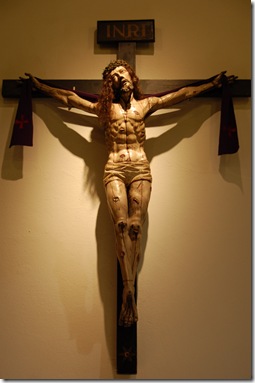 An image like the one at the left usually causes in most Lutherans a rather guttural reaction. Lutherans tend to either love crucifixes or hate them. One side says, “Jesus is no longer on the cross and so my crosses are always empty.†The other side says, “We preach Christ crucified.†Therefore, their mantra is “On every cross a corpus.â€
An image like the one at the left usually causes in most Lutherans a rather guttural reaction. Lutherans tend to either love crucifixes or hate them. One side says, “Jesus is no longer on the cross and so my crosses are always empty.†The other side says, “We preach Christ crucified.†Therefore, their mantra is “On every cross a corpus.â€
So which side do I fall on? Well, I do love crucifixes. I gave crucifixes to my confirmands this year. And yet I am not willing to chant the mantra. I tend to think that a variety of faithful images related to our Lord’s life is helpful to the church.
The truth is, the cross was once the place where the body of Jesus hung to work reconciliation between God and man. And so this image should be dear to any Christian. And yet, the cross was then found empty as Jesus’ body was placed in the tomb for three days before being raised up. The empty cross can serve as a powerful reminder of the resurrection.
To the “Jesus is no longer on the cross†crowd I say the following. You are right. He is not any longer dead but alive. But you should thank God every day that he was on the cross. You should remember that the cross is a powerful symbol of the faith only because the Lord’s body hung on it. If the image of Christ on the cross offends you, you need to ponder what that reveals.
1 Corinthians 1:22-24 For Jews demand signs and Greeks seek wisdom, but we preach Christ crucified, a stumbling block to Jews and folly to Gentiles, but to those who are called, both Jews and Greeks, Christ the power of God and the wisdom of God.
Only those who do not believe should be offended by the cross filled with the body of our Lord Jesus.
And if you truly wish to maintain that we can only have images that relate to the current reality of Jesus’ existence, only a picture of him seated at the right hand of the Father will do. Good luck getting that right. And don’t forget to burn up you’re your nativity scene since he is no longer in the manger either. Use that print of him at the Lord’s Supper as your kindling since he is no longer at that table either.
And if your problem is that you view the crucifix as too Roman Catholic, you need to ask yourself, how can Jesus hanging on the cross be described as anything other than universally Christian? What image better testifies to the heart of our faith, that Jesus died for our sins?
To the “a corpus on every cross†crowd I say the following. We have to keep this in perspective. A crucifix itself has no sacramental value. Our confessions rail against those who give the impression that such things have any value beyond a pedagogical value. A crucifix has great teaching value. It reminds us of the heart of our confession. But unless your people insist that Jesus on the cross is not the heart of our confession, then it would be dangerous, even idolatrous, to insist that every cross have a corpus. The church throughout time has certainly embraced the idea that a multitude of symbols and imagery is best for teaching, especially to the young and simple. Use what you have to teach and seek to explain about how a crucifix would provide another great way to teach the faith just like nativities, pictures of biblical events, and yes even empty crosses can.
Crucifixes are a wonderful thing. They gives our eyes a place to focus the confession of our hearts and lips. But they are not the only thing. Even an empty cross still confesses Christ.

I love crucifixes; often thought I’d like to collect different ones and display them. I do prefer them empty though. Growing up as a Roman Catholic they were only with the body of Jesus on them (Catholic school through 9th grade) and called a crucifix. “Crosses” were the ones without the body. For me, when I see one with the body I think Roman Catholic.
Very well stated, Phil.
One thing you did not mention is that in many Protestant Churches (even at HOpe) there is often a combination of cross with a Risen Christ (sometimes erroneously called Christus Victor) on it. I get what theological point it is trying to make; I just think it does so without regard to good aesthetics.
I would just like to add that in the Eastern Churches during the Paschal season, the Cross with corpus that was displayed prominently on Great and Holy Friday is still present in the nave but without the corpus. After Ascension, the Cross will be moved back behind the altar with the Corpus fastened back to it.
On our processional crosses, it is customary to have icons on both sides, one showing Christ nailed to the cross and on the other, Christ standing on top of his cross defeating death.
I don’t know. I cross without a corpus is sort’ve like an image of an electric chair without its victim. A cross without a corpus means that there is room for me.